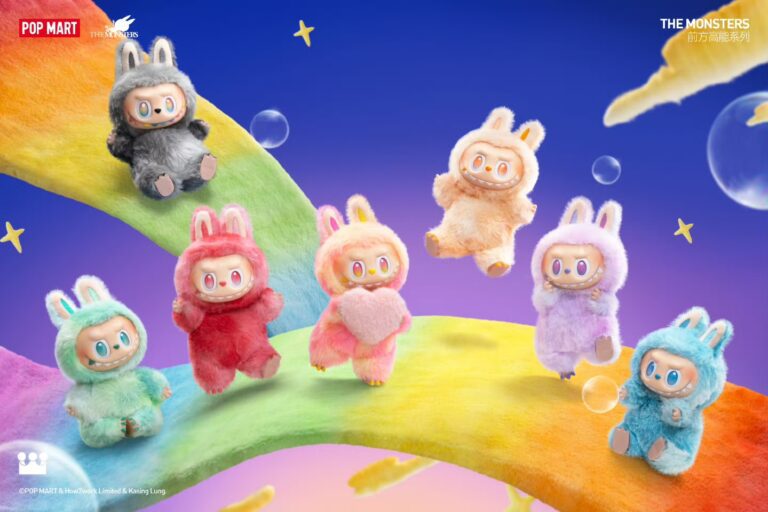Labubu, a brand under Chinese pop toy giant Pop Mart, has rapidly risen to global fame in recent months. Originally created by Hong Kong-born artist Kasing Lung as part of his Nordic folklore-inspired series, Labubu has become a popular icon in the designer toy world, known for its signature pointy ears, nine jagged teeth, and mischievous grin. Its popularity spans from China to Europe and from the US to Southeast Asia, symbolizing the growing international influence of Chinese pop culture.
On Tuesday, Pop Mart’s stock hit a record high, pushing its market cap past HK$310 billion ($39.7 billion) after rising more than 160% this year. In the first quarter, the company reported a 165–170% year-on-year revenue increase in China, while overseas sales surged nearly 480%, though it did not disclose specific revenue figures. For reference, its 2024 revenue reached RMB 13.04 billion ($1.83 billion), including RMB 7.97 billion ($1.12 billion) from China.
A fusion of artistic DNA and commercial strategy
Labubu was licensed from Lung by Pop Mart in 2019. Though not an immediate success, its blend of Nordic mystique and urban street style gradually won over young consumers in China.
Pop Mart’s blind box strategy, where the brand sells limited editions to customers without them knowing exactly what they’re buying, amplified its collectability and viral appeal by tapping into the thrill of chance, a mechanism often likened to low-stakes gambling.
Going global through celebrity power and cultural resonance
Labubu went viral for the first time in 2024 after Thai pop star Lisa, a member of Blackpink, showcased it on social media, triggering a fandom craze. In the same year, Thai Princess Sirivannavari also wore Labubu merchandise in public. In Southeast Asia, Labubu has become both a fashion symbol and a cultural token of good fortune, which has sparked trends such as “praying to Labubu for luck.”
In 2025, several global celebrities have helped elevate Labubu’s profile even further. Pop icon Rihanna shared a photo of her Labubu figure on social media, ex-footballer David Beckham showcased a Labubu gifted by his daughter, and Kylie Jenner’s daughter, from the famous Kardashian-Jenner family, was seen picking out figures at a Pop Mart store; British singer Dua Lipa has also expressed her fondness for the character.
Pop Mart’s strategy in the US and Europe includes pop-up stores in Los Angeles and London, plus collaborations with local artists and retailers. Highlights include a “Street Elf” line with a New York graffiti artist and a Hamleys exclusive range.

Challenges and controversies with scalpers and IP longevity
Surging demand has attracted scalpers and counterfeiters, especially in Southeast Asia. Scalpers have hoarded Labubu stock and inflated prices, making it hard for ordinary consumers to buy at retail price. Counterfeits and knockoffs have also flooded secondhand platforms. In response, Pop Mart has introduced real-name purchase systems and quantity limits, partnered with customs to crack down on smuggling, and used blockchain tech to authenticate limited editions.
A deeper concern lies in the sustainability of the brand. While Labubu has expanded beyond blind boxes into plush toys, apparel, and home decor, over-reliance on scarcity marketing may lead to consumer fatigue.
A symbol of Chinese cultural globalization
Labubu’s success marks a turning point for Chinese intellectual properties. Breaking the long-standing dominance of Japanese, Korean, and Western IPs, Labubu proves that original Chinese designs can resonate across cultures. With continued expansion in international markets and partnerships with global giants such as Disney and Universal Studios, Labubu is poised to bridge Eastern and Western trends.
Pop Mart founder Wang Ning once said, “Labubu’s pointy ears transcend language, but its essence is rooted in China’s understanding of global youth culture.”
Whether Labubu becomes a lasting global icon depends on Pop Mart’s ability to balance creativity and commercial success. But its rise has already made history in China’s designer toy industry.

Voices from the fan community: why collectors love Labubu
TechNode on Wednesday conducted an online interview with a Pop Mart collector who goes by the pseudonym Zi Yao.
Q: When did you start collecting Labubu, and what drew you to it?
Zi: I think I started collecting Labubu blind boxes around 2020. It was already quite popular among Pop Mart’s offerings at the time. What attracted me was its “ugly-cute” look. While most blind box IPs aim to make their characters cute or beautiful, Labubu stands out with its quirky, slightly odd appearance. That uniqueness really appealed to me.
Q: What’s your view on the randomness of blind box draws? How does it affect your purchasing decisions?
Zi: To me, blind box draws are essentially a form of gambling. But they’re easier to accept because you always get something in return for your money. You’re given a clear list of all the possible figures up front, and each series has a limited number of boxes, so it doesn’t feel like real gambling where you might lose everything. That said, the idea of a “limited total” can push people to keep buying, thinking “maybe the next one’s the rare one.” So sometimes I’ve ended up spending more than I initially planned.
Q: Have you ever paid extra on the secondary market for a rare figure? What’s your view on scalping and hype-driven pricing?
Zi: Yes, I’ve paid extra for rare figures on the secondary market. Hype and scalping may drive up purchases, but they also harm the brand’s reputation in the long run. Since many buyers are young people or even minors, who often lack strong self-control, it’s hard for them to resist the thrill of blind box purchases. I believe appropriate regulation is needed to curb this behavior.


